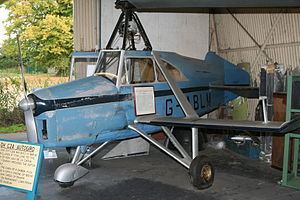Top speed 185 km/h First flight 1931 Designer Juan de la Cierva | Length 6.1 m Manufacturer de Havilland | |
 | ||
The de Havilland C.24 was a two-seat autogyro built by de Havilland at its Stag Lane works in England in 1931, using a Cierva rotor head coupled to the cabin of a de Havilland DH.80A Puss Moth, and driven by a 120 hp Gipsy III engine. It was withdrawn from use by December 1934.
A single example (G-ABLM) was produced and is part of the Science Museum collection. In 2008 it was on loan to the Mosquito Aircraft Museum at Salisbury Hall, near London Colney in Hertfordshire. In flight, it had a maximum speed of about 115 mph (185 km/h; 100 kn).
Specifications
Data from Jackson 1978 p.524
General characteristics
Performance
References
Cierva C.24 Wikipedia(Text) CC BY-SA
